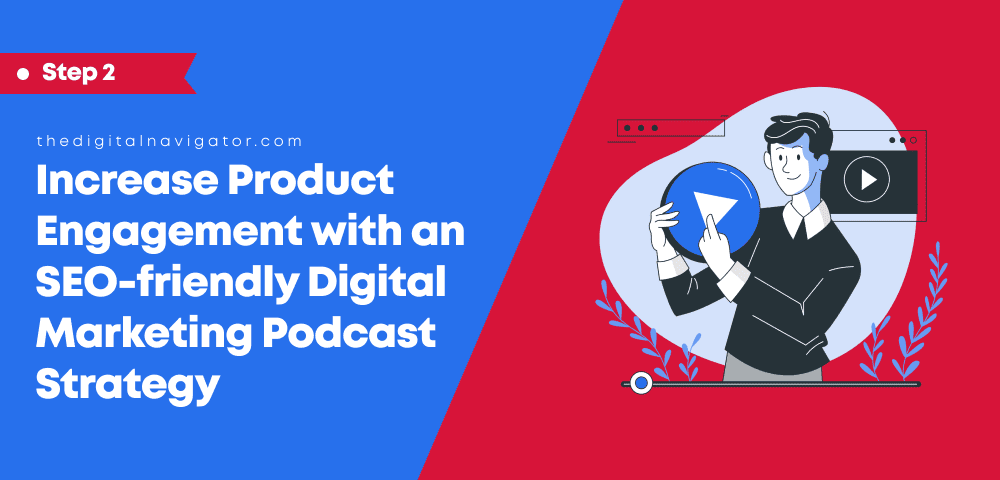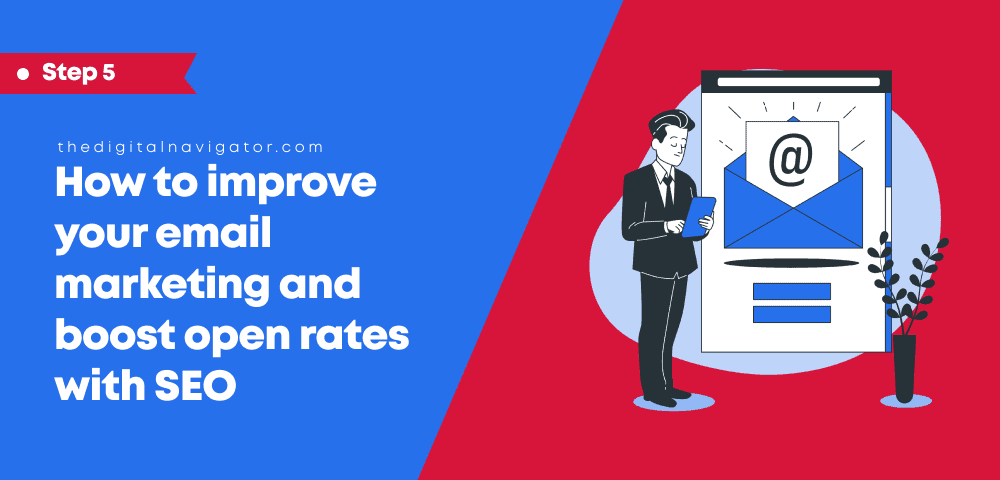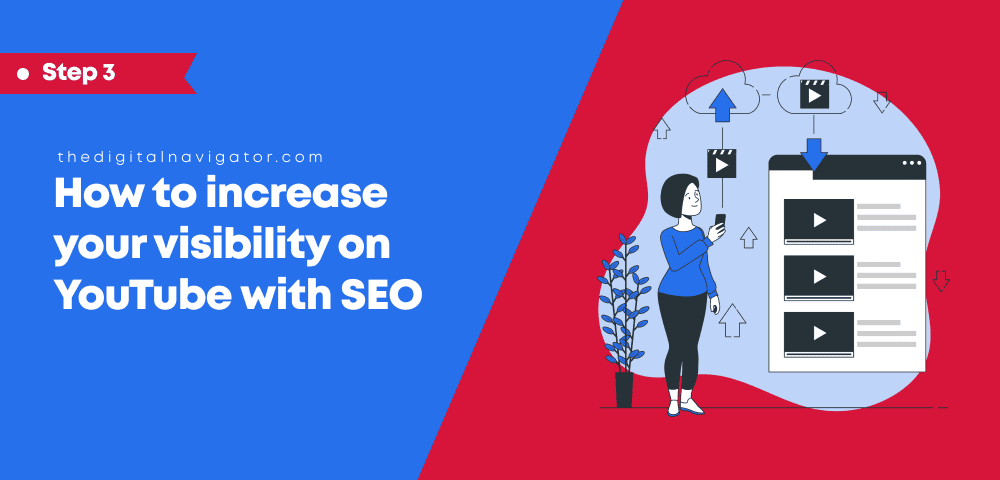Increase Product Engagement with an SEO-friendly Digital Marketing Podcast Strategy
Reading Time: 8 minutes
Learn to improve product visibility with this digital marketing podcast strategy catered to course creators and online trainers.
This post is part 2 of 5 in our Ultimate Guide to Maximizing Your Content Marketing with SEO.
- How SEO and Content Marketing Work Together to Boost Your Online Success
- Increase Product Engagement with an SEO-friendly Digital Marketing Podcast Strategy
- How to increase your visibility on YouTube with SEO
- Impact a larger audience with blog article SEO
- How to improve your email marketing and boost open rates with SEO
As online business owners, trainers, and course creators, we’ve all heard of guest posting and podcasting to increase our reach and foster awareness about our digital products.
The question is, how do we further leverage these kinds of digital assets to increase product engagement in the long-term?

Table Of Content
- Introduction
- Why should I be marketing my digital products with a podcast?
- 10 Simple SEO Tricks to Market Your Latest Podcas
- 1. Submit your podcast to directories like Apple Podcasts, Spotify, or YouTube Music (formerly Google Podcasts)
- 2. Keep a consistent posting schedule
- Use each podcast launch for social media content
- Do keyword research to boost your digital marketing podcast
- 5. Optimize Podcast Titles, Episode Titles and Descriptions for clarity
- 6. Create transcripts, summaries, and show notes
- Optimize your website for podcasts
- 8. Build a strong backlink trail with guest embeds
- 9. [Technical] Implement Schema Markup Code
- 10. Monitor and adjust your podcast marketing efforts
- A long-term look at the SEO of your digital marketing podcast
Sure, we can create social posts and buy paid ads to market these assets…
…but this is the kind of marketing effort that can ‘time out’ when not implemented properly.
Eventually, your social posts will move far down profiles and pages online, while paid ads will require constant investment to upkeep.
That’s why today we want to continue engaging with the topic of content marketing and search engine optimization (which we discuss extensively in our guide: How SEO and Content Marketing Work Together to Boost Your Online Success).
Specifically, we want to share with you the process that we use to market digital products using podcast content–a process that you can then apply to other content assets you create.
So, if you’re at a point in your marketing journey where you already have solid marketing funnels in place, and want to extend your existing efforts creating podcast content, then this short, ten-step guide is for you!
STOP! Aren’t sure whether you’re up to speed on how to market your digital products?
We recommend taking a moment to refresh your understanding of how to build high-converting marketing funnels using any of our comprehensive resources on the subject below:
Why should I be marketing my digital products with a podcast?
One of the things we often share with clients (even prospective ones) is the deep benefit of using free offers to increase your sales potential, particularly for your foundational programs, products, or courses.
That’s because, when you provide real, tangible value to your audiences for free, you’re also guiding new prospects into the first stages of your marketing funnel.
In other words, you’re fully free to build product awareness, but in a way that’s much less sales-oriented!
As such, a good podcast marketing strategy has an advantage in terms of capturing the attention of discerning customers and prospects, and leading them back to your website landing pages through what is called a multiplier effect.
The multiplier effect occurs when the content you create automatically adds to your marketing potential, without any extra work.
That means you effectively engage and convert prospects while also expanding your reach and generating revenue…all with a simple podcast appearance!
Considering that our fundamental marketing funnel template relies on a process of awareness engagement, conversion, and ascension, podcasts become the perfect recipe for marketing success.
They…
Use Our Free Marketing Funnel Template
A great podcast marketing strategy can do wonders for your business, so we thought we would put together 10 simple tricks we use when helping clients market their latest podcast.
Best of all, we’ve optimized these tricks for search engine optimization (SEO), so you can integrate the power of two tasks into one, streamlined process!
10 Simple SEO Tricks to Market Your Latest Podcast
Okay, so you’ve created a podcast episode.
Now what?
Here are the ten things we recommend you do to help boost your podcast marketing, and increase the marketing power of your business overall!
1. Submit your podcast to directories like Apple Podcasts, Spotify, or YouTube Music (formerly Google Podcasts)
Basic, but important, you want to start by getting your latest digital marketing podcast into as many podcast directories as possible.
Hit all of the big ones like Apple Podcasts, Spotify, or YouTube Music (formerly Google Podcasts), and then extend into smaller-scale (but growing) directories like Stitcher and Blubrry.
That’s the foundation of how to publish a podcast–and those systems can provide instruction on the best ways to upload.
Plus, the more places your podcast appears, the more potential listeners, and the more potential to increase your search engine rankings for that content!
2. Keep a consistent posting schedule
You want to pick a certain time to distribute your content, and stick to it throughout your content process.
Depending on your schedule, you may choose every Tuesday, or every other Monday–just know that consistency is what’s important.
That’s because when you build regular habits with your listeners, they become familiar with gaining access to your episodes, and are more likely to log on to access your episodes.
HINT: Worried about hitting a consistent publishing schedule? If you’ve been doing episodes for a while, you can simply use replays of past episodes and then re-upload them, indicating that they are a replay event. Don’t do this too often though–just when you need some extra time building more great podcast content.
This sort of consistency is most important in the early days of your podcast, so we would encourage you to create and launch as many episodes as possible.
Why?
Because your podcast’s visibility and discoverability in the charts normally depends on the number of downloads
Plus, consistency signals to search engines that your podcast is active and relevant, which will potentially boost its rankings on other platforms outside of the podcast directories you’ve chosen.
Use each podcast launch for social media content
Most likely, you are already announcing your podcasts on social media, but if not (or if you haven’t started yet), then make sure you’re publishing a post whenever you release an episode.
But that’s not all that’s possible when you start using your podcast content as a part of your social media content strategy.
For instance, if it’s an audio podcast, you can segment out different parts of the podcast, then record a video reiterating that content to post on socials. Riverside and Descript are examples of tools that will make this easy for you.
You can even use the audio itself over a graphic-based video for a quick post, though allowing your audience to see you will always have the advantage!
4. Do keyword research to boost your digital marketing podcast
Yeah, yeah, we hear all about keywords in digital marketing, but that’s just for written content, right?
Well, search engines like Google, Bing, and Yahoo all use algorithms to measure which terms are most searched in a given time period, and then use this data to compute which links rank where.
To make sure your podcast content is associated with high-ranking keywords, you’re going to want to use popular keyword research applications like Google Keyword Planner, Ubersuggest, or SEMrush.
So when you’re creating your podcasts, you can actually use keyword research to provide content ideas for what you’ll talk about with guests. Then you can add tags and other description notes with these same keywords to start ranking for them.
Which isn’t the only way to do it, mind you. We’ve had clients do it the other way around, and it works well for them to be inspired, and then to find keywords to match that inspiration.
Interested in learning more about keyword research and search engine optimization? Read our expert guide, Demystifying SEO, which unlocks all the SEO basics you need to market successfully online.
5. Optimize Podcast Titles, Episode Titles and Descriptions for clarity
Creating keyword-based titles and descriptions is often seen as a part of SEO, and that’s true; yet it is also worth mentioning the advantages you’ll get from cultivating clear, solutions-based titles to your podcasts, episodes and other descriptors.
Here is a little quick-tip list to help you get super clear on how to organize and title your podcast content for optimized marketing:
- Podcast Title: Choose a podcast title that accurately represents your podcast’s content and if you can, have it include relevant keywords. For example, if you were in the spirituality industry, you might call your podcast something like The Spiritual Voice to keep your priority theme front and center.
- Episode Titles: Craft an episode title that asks (or answers) a question your audience might have about your podcast topic or theme. Keep it short and keyword focused for SEO purposes, and consistent with the existing ‘voice’ or ‘tone’ of your brand.
- Episode Descriptions: Write detailed episode descriptions that highlight the main topics and keywords you’ve used in your episode title. We also recommend you include any transcripts and show notes for accessibility purposes (we’ll talk about creating those in a second). You can even provide time stamps for where certain content appears in the play-through of your podcast to help people navigate through episode content more quickly.
When you get very clear on how you are helping your audience, and support their journey in finding exactly the listening content they’re looking for, your podcast marketing will benefit from a huge boost!
6. Create transcripts, summaries, and show notes
Creating transcripts and summaries from your podcasts is something we’ve learned can be deeply valuable to the content or course creation experience.
Not to mention, it is an inclusive way to share your content with those who may be differently abled, or who prefer reading to listening.
We recommend creating the transcript using popular transcript software like HappyScribe, Descript, Riverside or Otter.ai. If you are on a tight budget you can use YouTube or Vimeo generated transcripts. Then, review the transcript for spelling and grammar, while planting some more of those keywords in the content where possible.
Then, copy and paste that transcript on any landing pages or descriptions that appear alongside your podcast, and you’ll get exponential gains from adding more SEO-friendly content on your posts and landing pages.
HINT: Use the transcripts and summaries you’ve created to spur the development of a blog article for your business! Break it up into different sections, paragraphs, lists, or questions, add a bit of light editing, and you’ll have another publishable piece of content that links to your original podcast!
7. Optimize your website for podcasts
We talked about adding your podcast to multiple directories online to boost podcast promotion, but a big part of connecting your content with your podcast episodes is to include them as separate pages or posts on your website.
The easiest platform to use when organizing your podcasts into pages is WordPress, but whatever site you use, you’re going to want to create individual pages for each episode that include the episode title, description, transcript, and any relevant images or videos.
Business Website Design
New websites and redesigns
Create a new website or update your existing design to drive more sales and set a solid foundation to scale your business.

8. Build a strong backlink trail with guest embeds
As a podcast host or guest, you are always interacting with another party or person in your podcasts. If you’re more of a solo-goer, it’s the audience who are interacting with you either during, or following, your broadcast.
As such, with backlinks and even podcast affiliate marketing, there are myriad opportunities for you to…
- Request that your podcast episode page be linked on guest or audience websites
- Acknowledge specific guests or audience members on your site to draw in their network
- Get connected with other reputable sources that improve your SEO standing online
The more backlinks you create, and the more lead opportunities you have out there which draw people to your podcast pages, the more authority you will have–not just from the audience perspective, but from search engines as well.
Basically, a ton of backlinks signal that you’re a credible source, so don’t miss out on an opportunity to share your work on other people’s websites!
9. [Technical] Implement Schema Markup Code
This tip is a little on the technical side, but can be used to help provide clarity to your developer or web master about what you want them to do.
So, what is Schema markup?
Well, it’s a small piece of code that can be added to your business website that ‘announces’ to search engine algorithms that your page is a podcast episode.
We won’t dig too far into how it works, but know that when you implement schema markup, your podcast will appear with richer descriptions and even as a snippet in popular search engine results pages.
10. Monitor and adjust your podcast marketing efforts
You likely already have a data analytics platform in place on your website (and if you don’t, we can help with that), which means you already have access to data on…
- How many visitors go to each podcast page?
- How long are they staying to listen to your podcast?
- Are podcast visitors taking any additional actions on your website, like signing up for freebies, or joining an email list?
Popular podcast syndication platforms like Libsyn, Spotify for Podcasters or Blubrry – as I mentioned earlier – also have that kind of data in place for you, so you can see the number of downloads by day and region.
However you end up measuring podcast views, your main goal will be to stay in touch with what’s happening with your traffic. It’ll also help you answer questions like:
- What are the most popular podcast topics on your site?
- How are people responding to popular podcast topics?
- When are listeners most likely to view your podcast
The answers to these questions are vital as you continue to monitor and optimize the performance of your podcast, and your podcast marketing strategy.
This is how you see which keywords are driving the most traffic to your site, which empowers you to adapt your SEO strategy accordingly.
A long-term look at the SEO of your digital marketing podcast
It’s important to remember SEO is a long-term strategy, so it may take time to see significant results.
Bear in mind though, that all of your work has great potential to pay off big dividends, as it did for Jen Gilchrist, one of our top-performing clients at The Digital Navigator.
In fact, with our Small Business SEO services, Jen was able to create a six-figure training business in just 20 months!
Get help marketing your podcast
That being said, we understand the desire to DIY a lot of the work we do behind the scenes.
For those of you who are confident in moving forward solo, we next recommend you explore our expert guide to Demystifying SEO, as well as our free masterclass on how to create a lucrative marketing funnel for your course or program offering.
And as always, stay patient! Keep refining your approach, and continue lovingly producing high-quality podcast content that resonates with your target audience, and you’re sure to shine!
FAQ
Where should I post my podcast online?
Hit all of the big ones like Apple Podcasts, Spotify, or YouTube Music (formerly Google Podcasts), and then extend into smaller-scale (but growing) directories like Stitcher and Blubrry. Make sure you’re also posting on your own website.
How do I create a transcript from my podcast episode?
Popular transcription apps like HappyScribe, Descript, Riverside or Otter.ai can be used to speed up the transcription process, and ultimately save you a ton of time with podcast page development.
What other ways can I improve the SEO of my website content?
We recommend using our Free Marketing Funnel Template, as well as our free expert guide to Demystifying SEO. Together, they should give you a comprehensive education on improving the SEO and visibility of your website content.








0 Comments